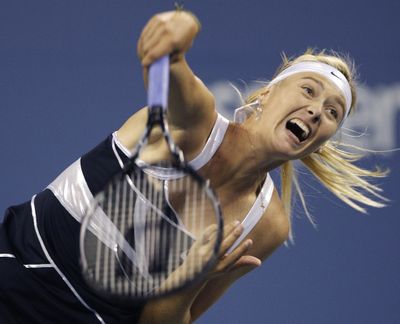Sharapova glad to be back
Missed last U.S. Open because of injured shoulder

NEW YORK – Maria Sharapova simply couldn’t bear the thought of a U.S. Open taking place without her.
So while sidelined with a torn shoulder a year ago, she refused to follow the tournament on TV. She basically pretended it wasn’t happening.
On Tuesday night, Sharapova was right where she likes to be: on the Grand Slam stage and in the spotlight. The 2006 U.S. Open champion returned to the tournament with an impressive 6-3, 6-0 victory over Tsvetana Pironkova of Bulgaria.
“I was in the physical therapy office every single day, and the tennis was on. But I made a point not to watch it,” Sharapova said. “When you’re not participating in a tournament that you very much love, and you’ve had success at, as an athlete and as a competitor, to not be there and not be competing is pretty tough.”
Against her 98th-ranked opponent, Sharapova’s game was as glittery as her black-and-silver dress, an outfit she described as a tribute to New York’s skyline. The three-time Grand Slam title winner produced 29 winners – 23 more than Pironkova. Sharapova’s game was particularly clean in the second set, when she hit 16 winners and only five unforced errors.
Apart from four double-faults, Sharapova showed no signs of the shoulder injury that forced her to have surgery in October and kept off the tour for nearly 10 months.
“This is a Grand Slam. You’ve got to get going from the first match,” Sharapova said. “After being gone, this is what it’s all about.”
Tell that to Ana Ivanovic or Dinara Safina.
Earlier in the day, Safina came perilously close to becoming the first No. 1-seeded woman to lose in the U.S. Open’s first round. But she eked out a victory over an 18-year-old from Australia who is ranked 167th and needed a wild-card invitation to get into the tournament.
The worst showing by a top-seeded woman in New York came last year, when Ivanovic exited in the second round. Now seeded 11th, Ivanovic did herself one worse this time, losing in the first round to 52nd-ranked Kateryna Bondarenko 2-6, 6-3, 7-6 (7).
“It hurts. I can tell you that,” Ivanovic said. “I’m sure I will have sleepless nights.”
At least the 2008 French Open champion had a big support group in the stands, cheering for her wildly. Safina, in contrast, would look up at her coach for positive body language, and instead, he’d cover his eyes with his hands.
Nearly undone by 11 double-faults and 48 total unforced errors, Safina was a point away from a 4-0 deficit in the third set before coming back to beat Olivia Rogowska 6-7 (5), 6-2, 6-4.
Safina, younger sister of 2000 U.S. Open champion Marat Safin, is used to faring well in the early stages of Grand Slam tournaments. Usually, it’s later on that problems arise: She is 0-3 in major finals, all lopsided losses, and managed to win only one game against Venus Williams in the Wimbledon semifinals in July.
“I was surprised that, you know, she was giving me free points,” said Rogowska, who never has defeated anyone ranked better than 47th.
As Rogowska spoke, her eyes were red, and she fiddled with a well-worn tissue.
“I’m disappointed I lost,” she said, “and I didn’t expect to say that after playing the No. 1 player in the world. It’s a bit weird.”